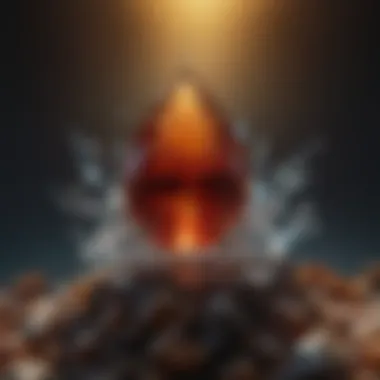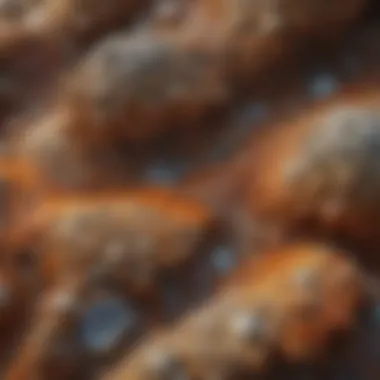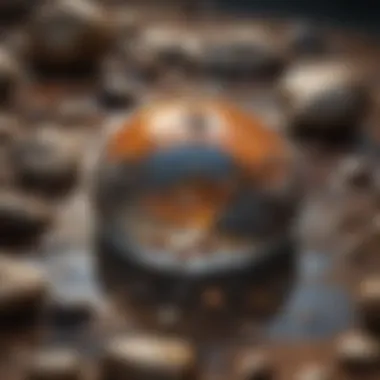Unveiling the Intricacies of Lapidary Drip System: A Geological Marvel


Rock and Fossil Identification
Lapidary drip systems, a methodology intricately intertwined with the art of collecting rocks and fossils, require a keen eye for detail and an appreciation for geological specimens. When embarking on an exploration of this technique, it becomes imperative to understand the nuances of identifying various types of rocks and fossils. This process involves discerning characteristics unique to each specimen, such as color, texture, and composition. Tools play a pivotal role in this phase, aiding enthusiasts in magnifying the details and uncovering hidden features that signify the nature of the specimen.
Collecting Tips and Techniques
For those delving into the realm of rock and fossil collection, mastering the art of collecting is a fundamental aspect of the journey. Adopting best practices ensures the preservation of specimens and maintains the integrity of geological treasures. Locating prime collection sites involves thorough research and exploration, scouring areas known for their rich abundance of rocks and fossils. Moreover, safely extracting specimens without causing damage requires expertise and precision in handling tools and delicate formations.
Preservation and Display
Preservation techniques are paramount in prolonging the lifespan of rocks and fossils obtained through lapidary drip systems. Understanding proper storage methods is key to safeguarding specimens from environmental factors that may degrade their quality. Moreover, exploring creative display ideas not only showcases the beauty of these geological wonders but also enhances the overall aesthetic appeal of collections.
Geological Insights
Delving into the geological insights offered by lapidary drip systems unveils a rich tapestry of Earth's history. By deciphering geological formations and processes through collected specimens, enthusiasts can reconstruct the narrative of our planet's past. The historical significance of rocks and fossils provides a glimpse into eras long gone, offering a tangible connection to the evolution of our world. Furthermore, notable discoveries in the field continually broaden our understanding of geological phenomena, sparking curiosity and driving further exploration.
Prolusion
Diving into the sophisticated realm of lapidary drip systems in rock and fossil collection opens up a gateway to the meticulous artistry and preservation techniques utilized by enthusiasts and professionals alike. In this article, we embark on a journey through the historical foundations, modern applications, and artistic perspectives that define this intricate method. By examining the key components, operational mechanisms, and innovation trends, we aim to provide a comprehensive guide for rock and fossil collectors seeking to elevate their craft.
Unveiling the Essence of Lapidary Drip System
The Origin Story
Exploring the genesis of lapidary drip systems unveils a tapestry of techniques and practices evolving over centuries. The roots of this method delve deep into antiquity, where lapidaries crafted geological treasures using rudimentary tools and age-old wisdom. The essence of this origin story lies in the ingenuity of our predecessors, who paved the way for modern lapidary practices. While challenging, the traditional approach instills a sense of craftsmanship and heritage that resonates with collectors worldwide.


Evolution of Techniques
The evolution of lapidary drip system techniques mirrors the advancement of technology and artistry in geological conservation. From ancient rudimentary methods to sophisticated abrasive elements and circulation mechanisms, this journey showcases the adaptability and innovation within the lapidary community. Embracing modern advancements while honoring traditional principles, lapidary practitioners continually refine their techniques to meet the demands of a changing landscape. The evolving techniques offer both advantages and challenges, providing a dynamic landscape for enthusiasts to explore and master.
Historical Insights
Lapidary drip systems possess a rich historical background that significantly influences their present-day application in the realm of rock and fossil collection. The evolution and progression of lapidary techniques throughout history lend invaluable insights into the cultural and practical significance of these methods. Understanding the historical context allows enthusiasts and collectors to appreciate the intricate processes involved in shaping geological specimens.
Ancient Practices
Cultural Significance
Exploring the cultural significance intertwined with lapidary drip systems unveils a tapestry of traditions and beliefs that have endured through generations. The profound connection between ancient civilizations and lapidary work highlights not just the utilitarian aspects but also the artistic and spiritual dimensions. The utilization of specific materials and tools in accordance with cultural practices showcases the reverence and attention to detail ancient craftsmen held for their craft.
Early Tools and Materials
Delving into the early tools and materials employed in lapidary practices brings to light the foundational processes that form the backbone of modern techniques. The utilization of rudimentary tools and naturally occurring abrasive elements underscores the ingenuity and resourcefulness of early lapidary artisans. Despite the simplicity of these tools, their effectiveness in shaping and polishing rocks and fossils remains a testament to the meticulous skill and craftsmanship inherent in ancient lapidary practices.
Fundamentals of Lapidary Drip Systems
When delving into the intricacies of lapidary drip systems, one must first grasp the fundamental concepts that underpin this technique. Lapidary drip systems play a pivotal role in the realm of rock and fossil collection, revolutionizing the way geological specimens are preserved and enhanced. Understanding the fundamentals is crucial to appreciating the intricate details involved in this process. The key components and operational mechanisms of lapidary drip systems are vital aspects that ensure the optimal preservation and treatment of these geological treasures.
Key Components
Abrasive Elements


In the realm of lapidary drip systems, abrasive elements serve as the cornerstone of the process. These elements play a pivotal role in shaping and refining the surfaces of rocks and fossils, contributing to the overall quality of the final product. The key characteristic of abrasive elements lies in their ability to effectively sculpt and polish geological specimens, enhancing their aesthetic appeal and scientific value. Abrasive elements are a popular choice in lapidary drip systems due to their precision and efficiency in rock and fossil treatment. Despite their efficacy, abrasive elements also present certain disadvantages, such as potential wear and tear on equipment, which must be carefully managed to ensure optimal results.
Circulation Mechanisms
Within the realm of lapidary drip systems, circulation mechanisms dictate the flow and distribution of abrasive elements, ensuring uniform treatment of geological specimens. The key characteristic of circulation mechanisms is their ability to regulate the movement of abrasive elements, optimizing the treatment process. This controlled flow is a beneficial choice for lapidary drip systems, as it guarantees an even and consistent treatment of rocks and fossils. The unique feature of circulation mechanisms lies in their ability to maintain a steady supply of abrasive elements to the surfaces of geological specimens, facilitating the treatment process. However, like any system, circulation mechanisms come with certain disadvantages, such as the need for precise calibration to prevent uneven treatment.
Operational Mechanisms
Flow Control Techniques
In the realm of lapidary drip systems, flow control techniques serve as the linchpin that dictates the pace and intensity of the treatment process. The key characteristic of flow control techniques is their ability to adjust the flow of abrasive elements, allowing for varying levels of treatment based on the geological specimen's requirements. This adaptability makes flow control techniques a popular choice in lapidary drip systems, as they cater to a diverse range of treatment needs. The unique feature of flow control techniques lies in their capacity to finely tune the treatment process, ensuring that each rock or fossil receives the precise level of care it demands. Despite their advantages, flow control techniques may pose certain disadvantages, such as the need for experienced operators to execute them effectively.
Preservation Methods
Preservation methods in lapidary drip systems play a crucial role in safeguarding the integrity and longevity of geological specimens. The key characteristic of preservation methods is their ability to minimize damage and degradation during the treatment process, ensuring that rocks and fossils retain their pristine conditions. This focus on preservation is a beneficial choice in lapidary drip systems, as it enhances the lifespan and quality of treated geological specimens. The unique feature of preservation methods lies in their capacity to protect rocks and fossils from external elements that could compromise their structural integrity. However, preservation methods also come with certain disadvantages, such as the need for specialized care and maintenance to uphold their effectiveness.
Modern Applications
In delving into the realm of lapidary drip systems, a crucial focal point is its modern applications. Today, the utilization of this technique goes beyond mere preservation; it embodies a synergy of tradition and innovation. Modern applications play a pivotal role in not only enhancing the aesthetic appeal of geological specimens but also in expanding the efficiency and precision of the collection process. By embracing contemporary approaches, collectors can elevate their craft to new heights, unveiling the hidden allure of rocks and fossils with unprecedented clarity and finesse.
Innovation Trends
Technological Advancements
Embarking on a discussion regarding lapidary drip systems' technological advancements uncovers a realm brimming with possibilities. The integration of cutting-edge technologies in this age-old practice revolutionizes how collectors engage with geological treasures. One key characteristic that sets technological advancements apart is their ability to streamline the cutting, shaping, and polishing processes, enhancing not only productivity but also the overall quality of the final pieces. The unique feature of these advancements lies in their precision and adaptability, offering collectors a sophisticated toolset to hone their skills and produce exceptional results. While showcasing significant advantages, such as time efficiency and intricacy in detail work, these innovations may also pose challenges in terms of initial investment and technical expertise.


Environmental Considerations
Turning our gaze to the aspect of environmental considerations within lapidary drip systems, a conscientious approach comes to light. The significance of incorporating sustainability into the collection and processing of rocks and fossils cannot be overstated. Environmental considerations offer a sustainable framework that aligns with the ethical mindset of modern collectors, fostering a harmonious relationship between artistry and environmental responsibility. A key characteristic of this approach is its emphasis on eco-friendly practices, minimizing waste and reducing the overall ecological footprint of lapidary activities. The unique feature of environmental considerations lies in their potential to inspire a new generation of collectors who are not only skilled artisans but also stewards of the earth. While presenting notable advantages such as promoting eco-consciousness and conservation, these considerations may require adjustments in traditional methods and material choices.
Enhancing Collectors' Experience
Enhancing the collectors' experience in the realm of lapidary drip systems is a critical aspect that adds a layer of depth and sophistication to the process of rock and fossil collection. By focusing on the specific elements that cater to collectors' needs and desires, this article aims to elucidate the significant role that enhancing collectors' experience plays in elevating the overall quality of geological specimen preservation and appreciation. Understanding the nuances of this enhancement can lead collectors to a more immersive and fulfilling journey in their passion for rocks and fossils.
Artistic Perspectives
Creative Utilization
Delving into the realm of creative utilization within lapidary drip systems unveils a world of possibilities for collectors seeking innovative approaches to rock and fossil manipulation. The key characteristic of creative utilization lies in its ability to blend traditional techniques with modern artistic interpretations, offering a fresh and dynamic outlook on the preservation and presentation of geological specimens. Exploring the unique feature of creative utilization allows collectors to experiment with unconventional methods and materials, paving the way for a more eclectic and personalized collection aesthetic. While creative utilization brings a sense of novelty and creativity to the process, its downside may rest in the potential deviation from traditional practices, requiring collectors to strike a delicate balance between innovation and preservation.
Aesthetic Developments
Shedding light on the domain of aesthetic developments in lapidary drip systems sheds light on the transformative power of visual appeal in enhancing collectors' experiences. The key characteristic of aesthetic developments lies in its emphasis on the beauty and visual allure of geological specimens, uplifting the overall presentation and desirability of the collection. Embracing aesthetic developments as a choice for this article stems from its ability to cater to the growing demand for not just scientifically significant specimens but also visually striking and emotionally captivating pieces. Describing the unique feature of aesthetic developments unearths a realm where artistry harmonizes with geological science, creating a seamless integration of beauty and meaning within the collectors' realm. While the advantages of aesthetic developments are clear in enhancing the overall allure of collections, potential disadvantages may arise from a shift towards prioritizing aesthetics over scientific or historical significance, necessitating a nuanced approach in balancing aesthetic appeal with factual accuracy in this article.
Epilogue
In the grand tapestry of lapidary drip systems, the Conclusion section acts as a crucial cornerstone, cementing the insights gleaned throughout this exhaustive exploration. By delving into the intricacies of this technique, readers embark on a journey that transcends mere theoretical understanding to practical application. At its core, the Conclusion crystallizes the essence of how lapidary drip systems revolutionize rock and fossil collection. Through a lens of foresight and reflection, we uncover not just the how but the why behind this art form; we unravel the threads that bind past practices with future innovations. As we navigate the labyrinth of geological preservation, the Conclusion serves as a compass, guiding enthusiasts towards sustainable practices and promising horizons in the world of lapidary art.
Looking Ahead
Within the horizon of possibilities, the Looking Ahead subsection beckons us to peer beyond the veil of the present and into the realm of future innovations and sustainable practices. This forward-focused segment invites speculation and contemplation on the evolution of lapidary drip systems, highlighting the transformative potential that lies untapped. As we brace ourselves for the winds of change, the allure of new methodologies and technologies casts a captivating spell, promising to redefine traditional paradigms. The Future Innovations segment channels our gaze towards uncharted territory, where cutting-edge techniques and advancements converge to reshape the landscape of lapidary techniques.
Future Innovations
Delving deeper into the realm of future innovations, we unearth a trove of advancements poised to revolutionize the way we approach lapidary drip systems. A beacon of progress, future innovations embody the spirit of ingenuity and exploration, offering a glimpse into a world where precision meets creativity. The key characteristic of these innovations lies in their seamless integration of cutting-edge technology and time-honored practices, creating a harmonious blend that marries tradition with innovation. As a beacon for enthusiasts and practitioners alike, future innovations pave the way for enhanced efficiency, unparalleled precision, and boundless creativity, setting a new standard in the lapidary world.
Sustainable Practices
As we pivot towards sustainable practices, we embrace a mindset that transcends mere conservation to embrace responsible stewardship of our geological heritage. Sustainable practices stand as a testament to our commitment to ethical sourcing, environmental consciousness, and long-term viability in the realm of lapidary art. The key characteristic of sustainable practices lies in their holistic approach, which ensures that the delicate balance between resource utilization and preservation is maintained. By championing sustainable practices, we not only safeguard the integrity of our craft but also pave the way for a more sustainable future where artistry coexists with eco-consciousness, enriching both our creations and our planet.







